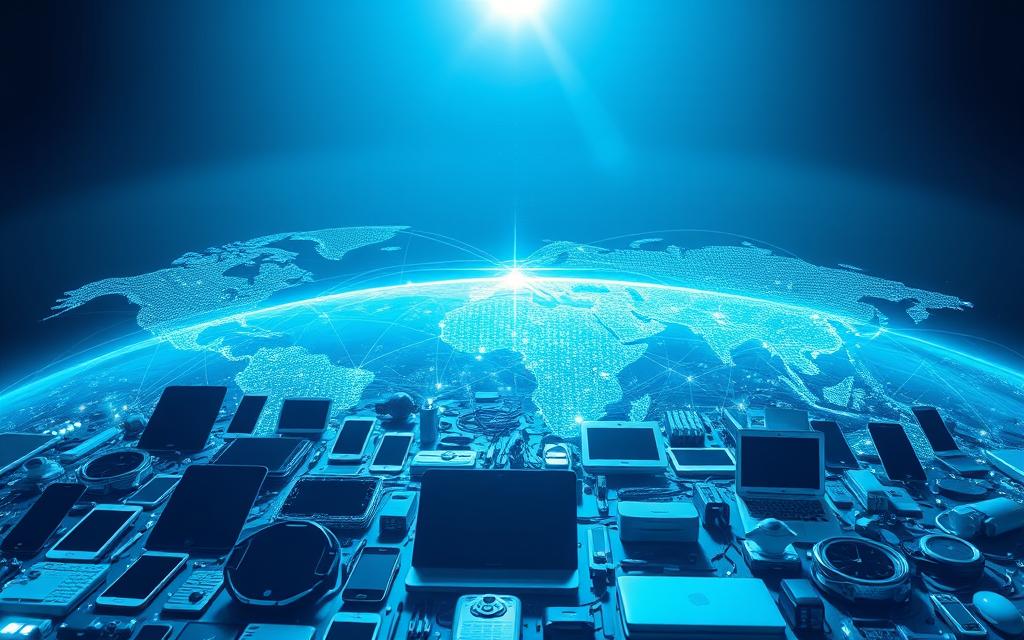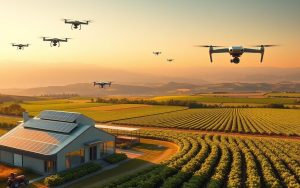The fast spread of new ideas across the world has changed how we do business. It has made innovation ecosystems that know no borders. Economist Joseph Schumpeter showed that global technology diffusion is key to making money from new discoveries.
Without people using these ideas, even the biggest breakthroughs can’t change industries. They stay in labs.
Studies show that new technologies grow in an S-shaped curve. At first, they’re tested. Then, they grow fast when everything is ready.
This happens much quicker now. For example, 5G and green energy have made huge progress in half the time of old.
Three things speed up this progress:
1. Working together on research projects
2. Rules for sharing ideas
3. Online tools for sharing knowledge fast
As countries focus on specific tech areas, we see how connected we are. No country can solve all big problems alone. The next parts will look at how old ways of sharing ideas compare to today’s fast world.
The Accelerating Force of Globalisation on Technological Exchange
In the 21st century, globalisation has changed how we share knowledge and develop technology worldwide. This change has made innovation ecosystems more connected than ever. International research collaboration and digital tools play key roles in this, removing barriers of distance.
Defining the Modern Innovation Ecosystem
Today’s innovation world is built on three main things: accessibility, speed, and diversity. Unlike old systems, today’s networks let researchers in Boston work with data from Singapore and advice from Europe.
Key Characteristics of Global Knowledge Sharing
Today’s knowledge transfer networks have unique traits:
- Decentralised decision-making across multinational teams
- Cloud-based platforms enabling 24/7 co-development
- Standardised protocols for data security and IP management
OECD data shows a 187% rise in cross-border patent filings from 2000. Tech hubs like Bangalore and Tel Aviv now make up 34% of global AI research papers through partnerships.
Cross-Border R&D Collaboration Patterns
Modern research partnerships follow certain patterns:
| Region | Primary Partners | Focus Areas |
|---|---|---|
| North America | EU, East Asia | Quantum computing, biotech |
| European Union | North America, ASEAN | Renewable energy, IoT |
| East Asia | Global South nations | AI ethics, 5G infrastructure |
“The average tech project now involves researchers from 6.8 countries compared to 2.3 in 1990.”
These patterns show how international research collaboration leads to specialisation. Companies now split R&D phases across continents. They use time zones and local expertise for ongoing development.
Historical Evolution of Technology Transfer
The sharing of technological knowledge across cultures shows our constant desire to innovate together. Over time, historical technology transfer has moved from accidental finds to organised global systems.
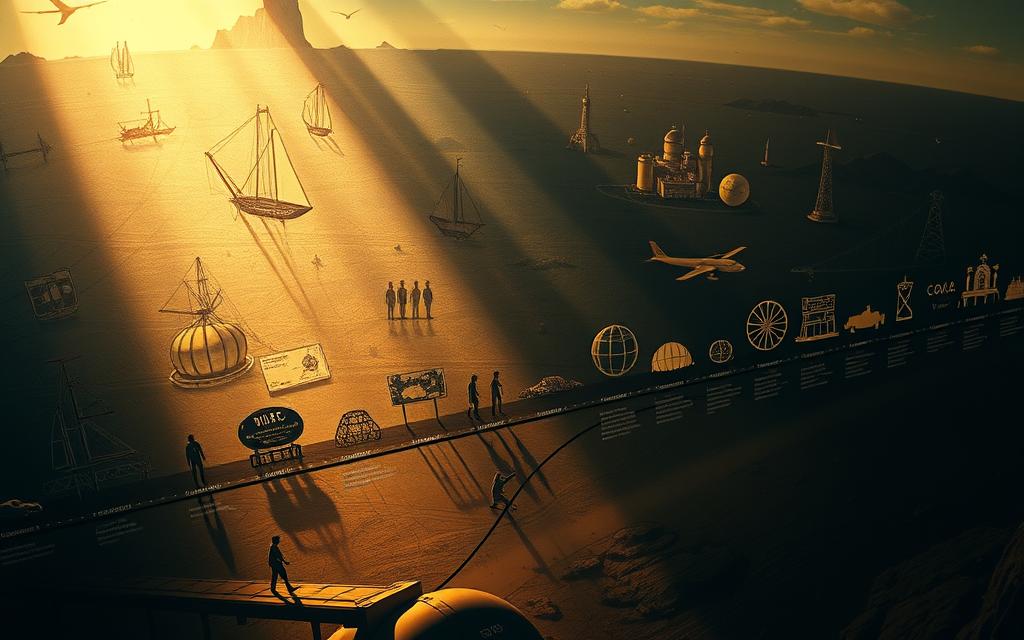
Pre-Globalisation Knowledge Diffusion (Pre-20th Century)
In the past, new ideas spread in unpredictable ways. This was often due to trade and power struggles.
Silk Road Exchanges and Early Innovation Spread
From 200 BCE to 1450 CE, the Silk Road helped move knowledge. It carried:
- Papermaking from China to Baghdad
- Astrolabe designs among Islamic scholars
- Numerical systems from India to Europe
Colonial-Era Technology Transfers
European powers took resources and knowledge by force. The forced transfer of steam engines to India (1750-1850) shows how technology helped control empires.
20th Century Industrial Globalisation
After World War II, new systems for industrial globalisation trends emerged. This is detailed in technology licensing studies.
Post-War Technology Licensing Agreements
Between 1945 and 1975, over 12,000 patent licences were made. These included:
| Technology | Licensor | Primary Recipients |
|---|---|---|
| Automotive manufacturing | US/Germany | Japan/South Korea |
| Petrochemical processes | UK | Middle East |
| Consumer electronics | Netherlands | Taiwan/Singapore |
Multinational Corporations’ Emerging Role
By 1980, big companies like IBM and Unilever were in 50+ countries. They led to:
- Standardised production
- Global R&D networks
- Upskilling workers
Digital Age Breakthroughs (1990s-Present)
The internet has changed how we share knowledge. It has made historical technology transfer faster and more global.
Internet-Enabled Collaboration Platforms
GitHub has 100 million+ repositories for developers. Video calls let engineers in different places work together.
Open-Source Movement’s Global Impact
Linux now runs 90% of cloud services. This shows how sharing knowledge can be more powerful than keeping it secret.
Global Supply Chains: Catalysts for Technological Dissemination
Now, technology moves around the world through global supply chains. These networks do more than just move goods. They share knowledge, improve processes, and help people learn new skills across countries.
Smartphone Manufacturing Case Study
Apple-Samsung-Foxconn Knowledge Network
The technology supply chains behind smartphones show a web of shared innovation. Foxconn’s Shenzhen facilities have over 300,000 workers. They work on:
- Testing Apple’s design prototypes
- Using Samsung’s display technologies
- Teaching advanced manufacturing skills
This partnership has sped up manufacturing knowledge transfer on a huge scale. Engineers from Apple, Samsung, and Foxconn share the best ways to:
- Use precision robotics
- Check quality
- Manage supply chains
Developing Nations’ Tech Adoption Through Component Production
Vietnam’s growth in electronics shows how component production boosts tech skills. Factories that started with camera modules now:
- Run semiconductor clean rooms
- Use AI for quality checks
- Train engineers in automation
Renewable Energy Technology Diffusion
Global Wind Turbine Supply Chains
Big names in wind turbines, like Vestas and Siemens Gamesa, have set up knowledge networks across three continents. Their supply chains help with:
- Improving blade designs from Danish labs
- Creating new materials in US labs
- Producing affordably in Brazilian factories
Solar Panel Production Knowledge Transfer to Emerging Markets
The International Solar Alliance has helped Indian makers use:
- German thin-film tech
- Chinese large-scale methods
- Desert-proof panels for Africa
This manufacturing knowledge transfer has cut solar panel costs by 38% in partner countries. It has also boosted local skills.
Digital Platforms Reshaping Innovation Landscapes
Collaborative digital spaces are changing how we find new technologies. They let people from all over work together on big problems. This has opened up new ways for crowdsourced innovation and distributed AI research, changing how we make progress.
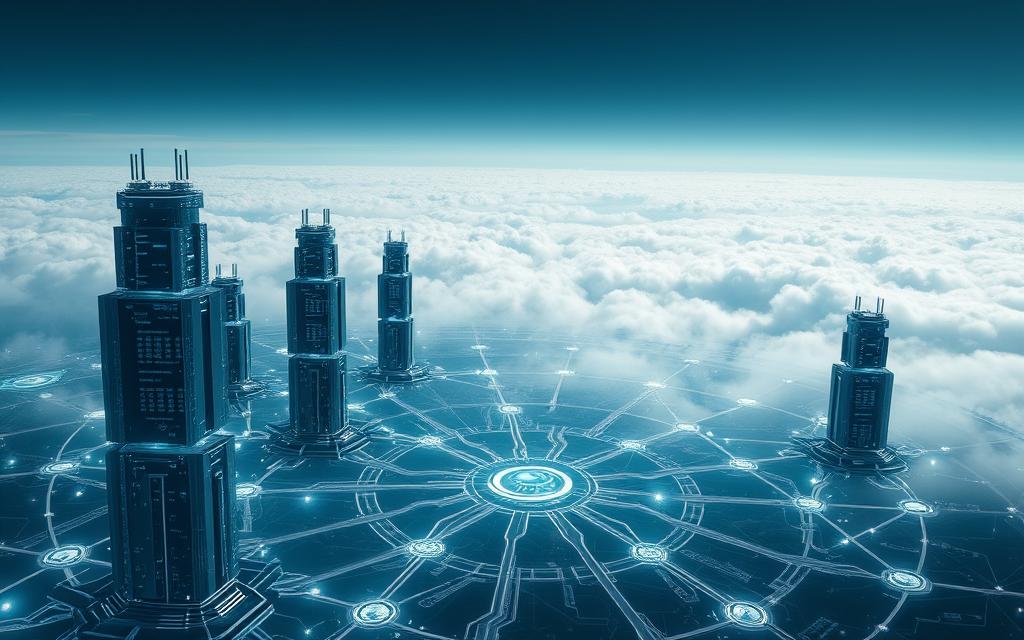
Crowdsourcing Technological Solutions
Today, solving problems often involves working with people all over the world. Digital platforms help companies find experts from different places and fields.
InnoCentive’s Global Problem-Solving Model
InnoCentive connects companies with over 500,000 solvers globally. They post challenges, from engineering puzzles to medical issues, and offer rewards for solutions. One company saved £2.1 million by getting help from the platform for a production problem.
GitHub’s Collaborative Software Development
GitHub has over 100 million repositories, showing how big collaboration can be. Developers in Lagos work on projects started in London, and engineers in São Paulo fix code from Seoul. This has made software development 40% faster than before.
| Platform | Approach | Scale | Impact |
|---|---|---|---|
| InnoCentive | Challenge-based crowdsourcing | 500,000+ solvers | 2,000+ solutions deployed |
| GitHub | Open-source collaboration | 100M repositories | 65M developers engaged |
AI Research Without Borders
AI development is now a global effort. Researchers from different places work together, sharing ideas to tackle big challenges.
DeepMind’s International Research Teams
DeepMind’s AlphaFold project brought together scientists from 20 countries. They mapped 200 million protein structures. A team in Canada worked with researchers in India, making a huge breakthrough in biology.
OpenAI’s Global Partnership Initiatives
OpenAI works with over 150 institutions worldwide to make AI benefits available to all. They helped improve Swahili NLP models in Kenya and created better algorithms for rainforest conservation in Brazil.
“The returns from global knowledge sharing far outweigh traditional proprietary approaches in accelerating AI ethics frameworks.”
Studies show that teams working together globally do better than teams working alone. A DeepMind engineer said, “Our breakthroughs happen at the intersection of disciplines – and passports.”
Barriers to Equitable Technology Distribution
The digital age promises progress for all, but big gaps in technology access show us obstacles. Two main issues stand out: laws that protect innovation too much and lack of physical infrastructure. These barriers keep billions from joining the modern world.
Intellectual Property Challenges
Global laws on innovation often favour big companies over people’s needs. The WTO TRIPS Agreement, signed by over 160 countries, shows this struggle between protection and access.
WTO TRIPS Agreement Implications
TRIPS rules on pharmaceutical patents have slowed down the production of generic HIV drugs in poor countries. During the COVID-19 pandemic, these rules also delayed vaccine access in Africa. This was despite efforts by South Africa and India to waive patents.
Pharmaceutical Patents vs Generic Production
India’s generic medicine industry, which makes 60% of the world’s vaccines, faces legal fights with patent holders. This fight makes life-saving treatments hard to get for 32% of people in low-income countries, according to WHO.
Digital Divide Persistence
Legal and physical barriers together create a “21st-century technological apartheid”, says the UN. The crisis in internet access in Sub-Saharan Africa shows the human cost of this divide.
Sub-Saharan Africa’s Internet Access Gaps
Only 28% of Africans use broadband internet, compared to 87% in Europe, ITU reports show. In rural areas, old copper-wire networks offer speeds under 10Mbps. This is too slow for modern healthcare or education.
5G Infrastructure Disparities
Seoul has 210,000 5G base stations, while West Africa has fewer than 500. This huge gap stops emerging economies from using IoT and smart city technologies.
We need to find ways to solve these problems together. Tech leaders are talking about open-source models and investing in infrastructure. But millions are stuck in the past while the digital world moves fast.
Economic Impacts of Technological Globalisation
Global technology is changing how we work and live, bringing both chances and challenges. Two big trends are leading this change: the fast growth of tech hubs and big shifts in the job market.

Emerging Tech Hubs Transformation
Now, special tech areas are boosting local economies with their focus and tools. These spots show how local ideas can make a big splash worldwide.
Bangalore’s Rise as India’s Silicon Valley
Bangalore’s IT exports hit $85 billion in 2023, making up 38% of India’s tech service earnings. It’s home to over 400 R&D centres for big companies like Google.
Shenzhen’s Evolution into Hardware Innovation Capital
Shenzhen filed 36,000 international patents in 2023, beating France and South Korea. It makes 90% of the world’s electronics parts, with leaders like DJI and Huawei.
| Tech Hub | Specialisation | Key Metric (2023) | Global Ranking |
|---|---|---|---|
| Bangalore | Software Services | $85bn exports | #1 IT Outsourcing |
| Shenzhen | Hardware Manufacturing | 36,000 patents | #1 Electronics Production |
Workforce Development Shifts
Global tech has made the job market more competitive, needing workers to adapt fast.
Global Competition for AI Talent
Meta and Alphabet now pay $1.2m on average for AI experts, up from 2018. China’s Tencent got 40% of its AI team from abroad last year.
Reskilling Initiatives in Manufacturing Sectors
Germany’s Industry 4.0 programme has retrained 280,000 factory workers in robotics. General Motors spent $27m on VR training for assembly line staff.
| Sector | Skill Gap | Response Strategy | Investment Scale |
|---|---|---|---|
| AI Development | 850,000 unfilled roles | Global talent acquisition | $4.3bn (2023) |
| Advanced Manufacturing | 1.2m workers needing retraining | Government-industry partnerships | $610m (EU programmes) |
Future Frontiers in Global Tech Collaboration
Nations face big challenges, and new ways of working together are needed. Quantum computing and climate tech show how we can make progress together. They mix competition and cooperation to bring about new discoveries.
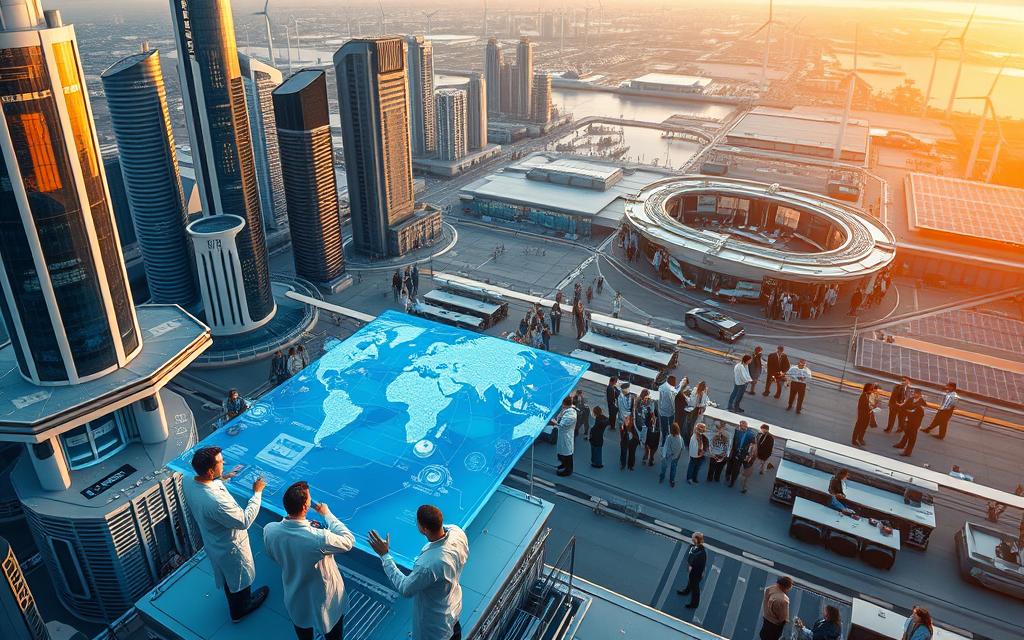
Quantum Computing Alliances
EU Quantum Flagship Programme
The EU has launched a €1 billion project to bring quantum computing to life. It brings together 5,000 researchers from 26 countries for 10 years. They aim to create quantum computers, simulators, and secure networks.
This project is different because it shares knowledge through ‘innovation hubs’. This helps new ideas move from research to real-world use in fields like healthcare and finance.
US-China Quantum Research Race
The US and China are racing in quantum research, but in different ways. The US limits China’s access to quantum tech, while China’s labs are growing fast. This raises big questions about keeping tech safe while making progress.
Climate Tech Partnerships
International Solar Alliance Initiatives
The ISA has 121 countries working together. They’ve installed solar power that’s like 63 coal plants. Their ‘One Sun Declaration’ helps share tech, focusing on storing energy from the sun.
Global CCS Institute’s Knowledge Sharing
The institute in Australia has a database with 140 carbon capture projects. It’s made sharing knowledge easier, cutting costs by 18% in three years. This shows how open data can help fight climate change.
“The next decade will be defined by our ability to reconcile national interests with planetary necessities in tech development.”
New ways of working together are changing how we innovate. The best ideas come from mixing competition with sharing knowledge. Success depends on creating systems where everyone benefits from progress.
Conclusion: Navigating the Global Innovation Ecosystem
Today’s tech world is all about working together. Big companies and new tech spots show how teaming up speeds things up. But, we need fair rules to make sure everyone gets a chance.
Good leadership is key. It means investing in digital stuff to help everyone get online. Places like South Korea and Germany show how working together can make clean tech bigger.
Leaders have tough choices to make. They must figure out how to share data and protect ideas without stopping new ideas. The World Intellectual Property Organisation has ideas for making this work.
The goal is to make tech work for everyone. It’s about finding a balance between making money and helping people. This balance is important for making sure new tech helps everyone, not just a few.
To succeed, we need to keep talking. Governments, companies, and schools must work together. By doing this, we can turn tech into real progress for all.
